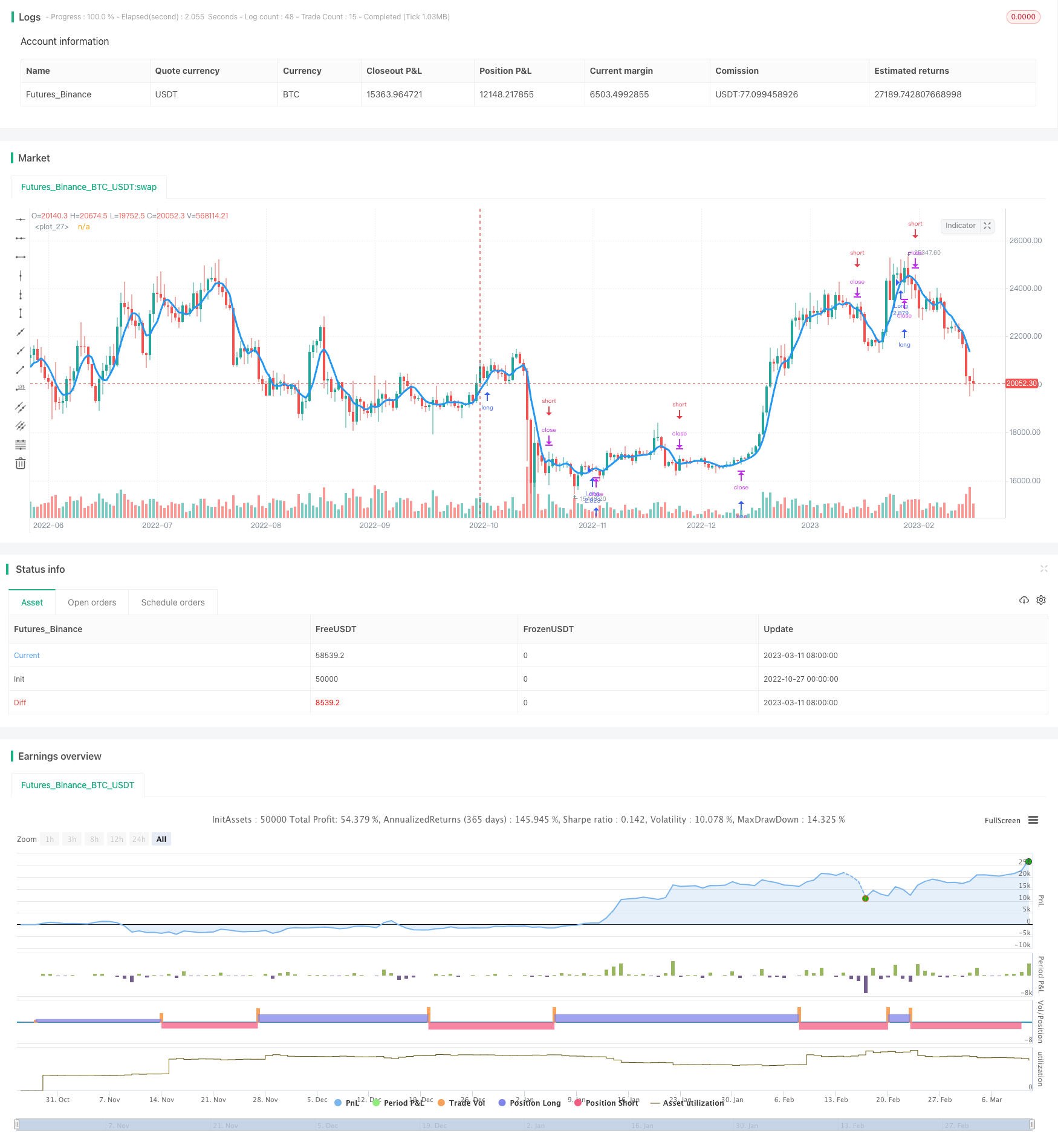
概述
该策略是一种趋势跟踪交易策略,使用简单移动平均线判断市场趋势方向,并在移动平均线上按照趋势方向放置限价单,实现趋势跟踪交易。
策略原理
计算简单移动平均线SMA,以及计算趋势方向trend。
如果启用了反锯齿过滤,则使用低点高于SMA判断为上涨趋势,使用高点低于SMA判断为下跌趋势。如果没有启用反锯齿过滤,则使用收盘价高于SMA判断为上涨趋势,收盘价低于SMA判断为下跌趋势。
根据趋势方向trend和启用的交易方向参数needlong、needshort,在SMA价格上放置限价单,具体逻辑是:
如果需要做多(needlong为true)且处于上涨趋势,在SMA价格放置做多限价单
如果需要做空(needshort为true)且处于下跌趋势,在SMA价格放置做空限价单
设置止损逻辑,如果持仓方向与趋势方向不符,则止损退出。
根据日期范围参数,只在指定的日期范围内交易。
优势分析
使用SMA判断趋势,可以有效过滤市场噪音,锁定较长线的趋势。
在SMA价格放置限价单,可以在趋势开始阶段获得较好的入场点位。
可选择只做多或只做空,灵活调整到个人交易风格。
可设置止损退出机制,避免亏损扩大。
支持设置交易时间范围,可避开重大事件导致的剧烈波动。
风险分析
SMA作为趋势判断指标,存在滞后问题,可能错过趋势转折点,从而出现损失。
限价单入场存在不够灵活的问题,可能因趋势短期调整而无法进入场内。
需要合理设置SMA周期参数,如果设置不当,会得到错误的趋势判断。
需要考虑交易时段参数的合理性,避免错过交易机会或风险时间段。
优化方向
可以考虑加入其他指标判断,进行多指标验证,避免SMA滞后问题。
可以设置成限价单追踪模式,当价格突破SMA时改为市价单追踪,提高跟踪灵活性。
动态优化SMA周期参数,让其自适应不同周期的市场环境。
设置止损位置成趋势内最低价/最高价,而不是严格的SMA位置,让止损更灵活。
增加算法交易元素,使交易时段更加智能灵活,避开重大风险时段。
总结
本策略整体是一个较为简单的趋势跟踪策略,核心思路是使用SMA判断趋势方向,并在SMA价格放置限价单进行跟踪交易,可通过一定优化提高策略的灵活性、适应性和智能性。该策略易于理解实现,适合算法交易入门学习,但实盘中需要注意风险,谨慎评估回测结果,并进行严格的监控与优化。
/*backtest
start: 2022-10-27 00:00:00
end: 2023-03-12 00:00:00
period: 1d
basePeriod: 1h
exchanges: [{"eid":"Futures_Binance","currency":"BTC_USDT"}]
*/
//Noro
//2020
//@version=4
strategy(title = "Noro's CrossLimit", shorttitle = "CrossLimit", overlay = true, default_qty_type = strategy.percent_of_equity, default_qty_value = 100.0, pyramiding = 0, commission_value = 0.0)
needlong = input(true, "long")
needshort = input(true, "short")
lotsize = input(100, defval = 100, minval = 1, maxval = 10000, title = "Lot, %")
src = input(close, defval = close, title = "MA Source")
len = input(5, defval = 5, minval = 1, title = "SMA length")
off = input(0, defval = 0, minval = 0, title = "SMA offset")
anti = input(true, defval = true, title = "Anti-saw filter")
rev = input(false, defval = false, title = "Reverse")
showma = input(true, defval = true, title = "Show MA")
showbg = input(false, defval = false, title = "Show background")
fromyear = input(1900, defval = 1900, minval = 1900, maxval = 2100, title = "From Year")
toyear = input(2100, defval = 2100, minval = 1900, maxval = 2100, title = "To Year")
frommonth = input(01, defval = 01, minval = 01, maxval = 12, title = "From Month")
tomonth = input(12, defval = 12, minval = 01, maxval = 12, title = "To Month")
fromday = input(01, defval = 01, minval = 01, maxval = 31, title = "From day")
today = input(31, defval = 31, minval = 01, maxval = 31, title = "To day")
//MA
ma = sma(src, len)[off]
macol = showma ? color.blue : na
plot(ma, color = macol, linewidth = 3, transp = 0)
//Background
trend = 0
trend := anti == false and close > ma ? 1 : anti == false and close < ma ? -1 : low > ma ? 1 : high < ma ? -1 : trend[1]
bgcol = showbg ? trend == 1 ? color.lime : trend == -1 ? color.red : na : na
bgcolor(bgcol, transp = 70)
//Signals
bar = close > open ? 1 : close < open ? -1 : 0
up = (trend == 1 and rev == false) or (trend == -1 and rev == true)
dn = (trend == -1 and rev == false) or (trend == 1 and rev == true)
//Trading
size = strategy.position_size
truetime = time > timestamp(fromyear, frommonth, fromday, 00, 00) and time < timestamp(toyear, tomonth, today, 23, 59)
lot = 0.0
lot := size != size[1] ? strategy.equity / close * lotsize / 100 : lot[1]
if trend != 0
strategy.entry("Long", strategy.long, lot, limit = ma, when = needlong and truetime and up)
strategy.entry("Short", strategy.short, lot, limit = ma, when = needshort and truetime and dn)
if size > 0 and needshort == false and trend == -1
strategy.exit("Stop Long", "Long", limit = ma)
if size < 0 and needlong == false and trend == 1
strategy.exit("Stop Short", "Short", limit = ma)
if time > timestamp(toyear, tomonth, today, 23, 59)
strategy.close_all()
strategy.cancel("Long")
strategy.cancel("Short")